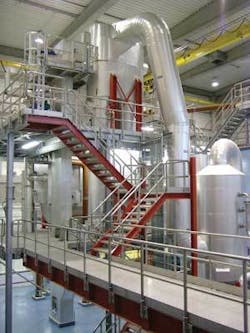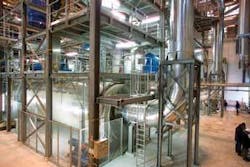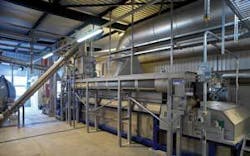Safe sludge disposal calls for thermal drying methods
Thermal drying provides a sustainable answer to sludge disposal and use given strict European Union environmental directives, public concerns, and the increasing volume of wastewater in Europe. The Austrian company Andritz AG, awarded the Frost & Sullivan 2004 Market Leadership Award for its long-standing domination of the drying segment in the European Sludge Treatment Equipment Market, provides an overview of sludge drying technologies developed for this growing market.
In Europe, environmental regulations and public pressure have helped develop the sludge treatment and disposal markets. Increasingly stringent land disposal regulations and steadily rising volumes of wastewater have created tough challenges for achieving efficient sludge management.
Public concerns that sewage sludge contains harmful substances and bears considerable environmental risks, such as biological activity of organic matter, heavy metal, hormones, and odor emissions, have prompted large demand for emerging “safe” sludge treatment technologies providing advanced solutions for sludge reuse and energy recovery.
The Austrian company Andritz responded to these evolving market demands by developing innovative sludge drying equipment that produce a valuable dried product that can be handled, treated, stored, disposed of, and used easily and safely. Andritz is renowned for its expertise in the sludge drying equipment technology and is currently a market leader for this technology.
Market trends
The European Landfill Directive stipulates that material with an organic content greater than five percent cannot be disposed on landfill, which has seriously affected traditional sludge disposal routes. Consequently, this legislation has directed sludge disposal trends towards thermal utilization.
Although agriculture still remains the main sludge disposal route, thermal utilization techniques such as drying, co-incineration and mono-incineration, are increasingly recognized as reliable and sustainable solutions for transferring sludge waste into a valuable product. Sludge waste is now considered a product that can be handled, treated, stored, disposed, and even used safely as secondary fuel.
Thermal drying is increasingly being viewed as a rapidly growing market primarily boosted by the need for safe sludge disposal and volume reduction. Technologically advanced countries in Western Europe already share this view.
Volume reduction has been the focus of attention as long as sludge has been considered waste; therefore the lowest achievable water content plays an important role in the treatment, storage, transport, disposal and utilization of sludge. Drying evaporates most of intracellular and chemically bound water, providing dry granules, which are easy to store, transport and dispose. Ideally volume reduction should lead to odor reduction and biological stabilization of the organic matter in order to prevent degradation of the biomass.
Enhanced thermal treatment is necessary in order to convert sludge to a product. Sludge contains several nutrients, including nitrogen, phosphorus, potassium, micronutrients, and organic compounds, and can be used as fertilizer as long as the product is fully pasteurized and fulfils the requirements on heavy metal concentrations.
Another beneficial use for dried sludge stems from its heating value. The calorific value of fully dried sludge (>90% DS) is roughly equivalent to that of brown coal, at approximately 11.000 kJ/kg. It can be used as secondary fuel, for coal-fired power plants, waste incinerators or as an additive in cement and brick production replacing primary fuel.
Andritz sludge-drying technologies Drum Drying System (DDS)
Mechanically dewatered sludge is fed into the drying plant where sludge is dried by evaporating the water in a triple-pass drum dryer, which consists of three concentric cylinders, and one joint axis.
To ensure the formation of granules, the feed to the drying drum is kept at approximately 65 percent dry solids (DS). This is achieved by mixing the mechanically dewatered sludge with a certain portion of already dried granulate. A feed of lower solids content has to be prevented because of the extremely sticky properties of the sludge, which may cause it to adhere to the drum surface or create lumps.
As the drum turns slowly, the sludge moves forward in the air stream, from the inner cylinder to the one in the middle and finally into the outer cylinder. During this process the granulate conducts a rolling motion that contributes to the formation of stable, globular granulate.
Water evaporates from the pre-formed granulate in the rotating triple-pass drum. The air stream and the drum rotation cause the material to move across the drum until it is sufficiently dry (and light) for pneumatic discharge. Smaller and thus lighter particles are discharged more quickly than larger and heavier particles, which ensures the same drying result for particles of different size und therefore provide a very homogeneous dried granulate.
After passing the drum, granulate has a dry solids content equal to or greater than 90 percent. Next, the circulating air stream carries granulate to the preseparator and polycyclone. In the preseparator, granulate is separated from the air and directly discharged via cooling device as final product. Separated fines and dust from the polycyclone are led back into the drying circuit.
After separation of the dried sludge particles from the air stream, warm and wet air enters the condenser where the water evaporated during the drying process. The air is routed back to the furnace to be re-heated to process temperature. After the condenser, some of the air is separated from the circulating air stream and led to an exhaust air treatment.
Possible energy sources for sludge drying with the drum dryer are primary energy and waste energy. Primary energy includes natural gas, biogas, and light oil. Examples of waste energy include exhaust gases from gas turbines, gas engines, and off gas from incineration processes.
About 90 Drum Drying lines are in operation around the world. The first one has been operating since 1974 to the customer’s satisfaction. The largest Drum Drying system will be installed in Singapore. This plant comprises five lines of Andritz DDS with a capacity of 11 tons water evaporation / hr each. More than 60 tons of dewatered sludge per hour will be converted to product. This will be the largest facility of its kind in the world.
Fluidized Bed Drying System (FDS)
A fluidized bed is characterized by the movement of granules, achieved by a gas stream passing through the bulk of product. Fluidization gas is uniformly blown over the entire cross-section of the dryer generating a fluidized bed consisting of dry granulates. The granules become free-floating and at the same time mixed thoroughly.
The fluid bed dryer itself consists of three main sections:
• Wind box with a gas distribution plate;
• Middle section, holding the heat exchanger immersed in the fluidized bed. This heat exchanger transfers all the required energy for evaporating the water coming along with the wet sludge. Steam or thermal oil is ideally the heat transfer medium.
• Dryer hood, first separation step for particles lifted from the layer with the fluidization gas. The gas leaves the dryer carrying the evaporated water and fines.
Dewatered sludge is directly fed into the fluidized bed, which is already filled with dry granules. Granulation occurs spontaneously by water evaporation and the particle movement in the dryer. The dryer operates in a closed inert gas loop. The recycled gas leaving the dryer hood carries evaporated water and fines. The fines are separated in the cyclone and the evaporated water is condensed out of the gas stream in a scrubber-condenser. The dust is fed to a mixer and structured together with the original dewatered sludge.
The dry, dust-free granules leaving the fluidized bed unit through the discharge opening are cooled by a vibrated fluid bed cooler to a temperature below 40°C and are ready for further use.
More than 40 Andritz fluid bed-drying systems are installed in the municipal field. The largest FDS installation (in one single line) is located in Susteren, The Netherlands, which converts 11 tons of dewatered sludge per hour into a valuable, dried product.
Belt Drying System (BDS)
This type of dryer consists of similar peripheral equipment as the DDS and FDS systems. The dryer is designed as a belt conveyor in a casing where the drying gases are flowing through granulate, which is evenly distributed on top of the belt. The slow moving belt enables the drying gases to heat up the wet granulate and evaporate the water whereas the granulate bed acts as a filter media to prevent dust generation inside the dryer. The low operating temperature (around 110°C - 150°C) and low dust amount ensure safe operation even without inertization inside the dryer which is required in any case in the DDS and FDS process.
The belt dryer is the ideal unit for integration of all forms of primary and especially secondary energy sources, which makes it highly economical. Fifteen belt dryers have been sold in Europe since 2003.
Three alternatives are possible:
• Direct heating with burner (heat is generated by burning fossil fuel / biomass (natural gas, biogas, fuel extra-light);
• Indirect heating with burner and heat exchanger;
• Indirect heating with heat exchanger (heat is generated with saturated steam, thermal oil, hot off gases, hot water etc.)
Dried sludge applications
Dried granules offer a wide range of applications that overstep the traditional applications of agriculture and incineration. Agricultural fertilizer remains the principal use. The biological stable (high degree of pathogen kill) and nutrient-enriched dried granulate is easy and safe to handle. But EU legislation is getting more and more severe under the light of bovine spongiform encephalopathy (BSE), heavy metals, and hormones carried with the sludge. BSE is a progressive neurological disorder of cattle that results from infection by an unconventional transmissible agent termed a prion.
Sludge reuse as fuel provides a compelling alternative. Thermally dried sludge can be used as an alternative fuel in coal-fired power plants, cement plants, waste incinerators and vitrification processes. Most importantly, the use of sewage sludge as fuel reduces carbon dioxide emissions.
Energy recycling is also an attractive option. Andritz developed the ECO-DRY process that dries dewatered sludge without using primary energy. This dried sludge is used as fuel for the cyclone furnace producing the required heat for the drying process. The ECODRY process uses the calorific value of the sludge for its disposal without the need for any other fuel. The ash produced from this process is ready for use in road construction work or for landfill, meeting even the most stringent requirements in Central Europe.
In summary, increasingly strict legislation is driving the thermal treatment market. The disposal of sludge by landfill or agricultural use is expected to decrease due to quality issues, public opposition, and restrictions on landfill materials. Therefore, thermal sludge drying technologies are likely to be employed given its recognized benefits:
• Highest volume reduction, which minimizes transport costs;
• Safe and easy handling of final product;
• Highest thermal efficiency and substitution of primary energy sources;
• Use of the inherent calorific value of solids in sludge;
• CO2-reduction by using sewage sludge as fuel.
Authors’ Note
Senior Sales Manager Dr. Doris Thamer and Senior Process Manager DI Werner Jenewein work for Andritz AG, based in Graz, Austria.



